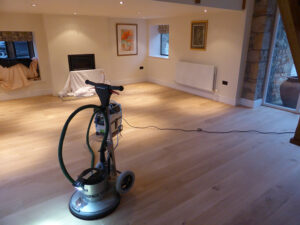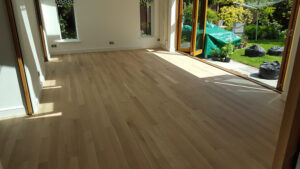If you are considering restoring your wood floors, there are some floor sanding mistakes that you should be aware of. Gaining knowledge and understanding of the process prior to completing the task will pay dividends to the end result. Achieving a smooth finish not only looks great but offers great reward. Here are just some of the common mistakes made:
- Using the Wrong Grit Sandpaper
 We would say that this is by far the most common floor sanding mistake. Granted, it takes experience to know exactly how to approach this, but that is why floor sanding professionals are such an important resource. We cannot stress enough how important it is to not start to sand with a paper that is too fine.
We would say that this is by far the most common floor sanding mistake. Granted, it takes experience to know exactly how to approach this, but that is why floor sanding professionals are such an important resource. We cannot stress enough how important it is to not start to sand with a paper that is too fine.
What grit you start with will depend on what your floorboards are like. If they have been sanded previously, they may need a refresh. This will mean that a finger-grade sandpaper can be used. However, in most cases, it is best to start with a much coarser paper than you expect.
If your floors haven’t been sanded before, the maximum grit paper you should start sanding with is 24 grit. This will work to sand away the old coatings, dirt and old varnish.
Using the wrong grit (too fine) will also mean that your sandpaper clogs up really quickly. Clogged up paper is useless so it is something you will want to avoid.
- Not Sanding Enough
 Floor sanding is physically tiring and draining. There really is no polite way of putting it. When you begin the process, you see an instant and big difference in the boards. Once you have removed most of the old coatings and dirt, the progress starts to feel much slower.
Floor sanding is physically tiring and draining. There really is no polite way of putting it. When you begin the process, you see an instant and big difference in the boards. Once you have removed most of the old coatings and dirt, the progress starts to feel much slower.
Floorboards are not always completely flat. This means that the drum of the floor sanding machine cannot reach all areas of the boards in one go. Shadows can therefore be left at the edges of the boards or in the middle (if the boards are convex).
Sanding these last bits away can definitely be a frustrating part of the floor sanding process as progress will seem almost non-existent. Keep sanding until all marks and shadows are completely removed.
- Not Changing the Sandpaper Often Enough
Changing the sandpaper more frequently will allow you to sand the floors much quicker. You are never going to save time by keeping the same piece of sandpaper too long. Your time is precious, and it is important to use it wisely.
Are you looking for help to re-sand and restore your beautiful wooden floor? Don’t suffer the above floor sanding mistakes. Call 1 Stop Floor Care today on 0800 852 7177.

Leave A Comment